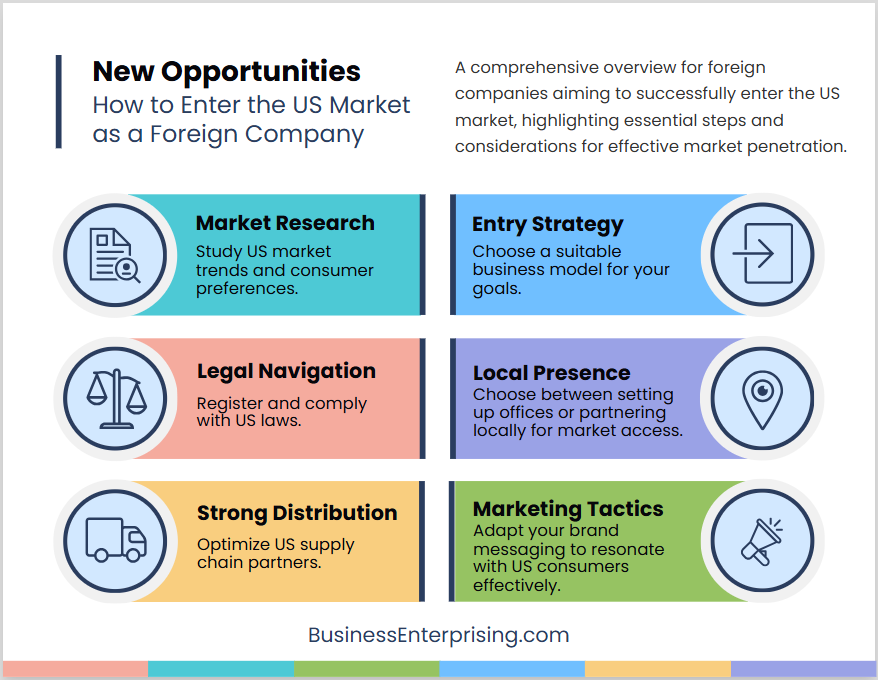
However, the US market is highly competitive, with established players across many industries. Therefore, identifying your niche and differentiating your brand is key. By researching market trends and consumer behavior, you can tailor your approach to meet local demands.
Entering a new market can seem challenging, but careful preparation makes the process manageable. By focusing on strategy, flexibility, and customer needs, you can position your business for growth and long-term success.
Understanding the US Market
Understanding the US market is an essential step when considering how to enter the US market. The United States is a large, diverse economy with significant regional differences. Therefore, recognizing these variations can help you identify where your products or services will perform best. Additionally, analyzing economic trends and industry growth rates provides valuable insight into potential opportunities.
Consumer behavior in the US also varies by region and demographic. For example, preferences in urban areas often differ from those in rural communities. Moreover, factors like income levels, cultural influences, and spending habits play a significant role. Conducting thorough research helps you understand these differences and align your offerings with customer expectations.
Market research is a critical tool for identifying challenges and uncovering opportunities. For instance, analyzing competitors’ strategies can reveal gaps in the market or underserved audiences. Additionally, researching customer needs allows you to tailor your value proposition effectively. By approaching this step strategically, you can build a foundation for long-term success in the US market.
Legal and Regulatory Compliance
Understanding legal and regulatory compliance is essential when planning how to enter the US market. The United States has complex business laws, tax structures, and licensing requirements. Therefore, researching these elements thoroughly helps you avoid costly mistakes and delays.
US tax structures vary by state and include federal, state, and sometimes local taxes. Additionally, different states have unique sales tax rates and rules. It’s important to understand these variations to budget accurately and comply with all regulations. You should also review business entity options, as tax obligations differ for corporations, partnerships, and sole proprietors.
Intellectual property protection is another critical area to address. Registering your trademarks, patents, or copyrights in the US protects your brand and assets from infringement. Additionally, staying informed about labor regulations, such as minimum wage laws and employee rights, ensures compliance with employment standards. These steps safeguard your operations and reduce legal risks.
Navigating these complexities requires preparation and, often, expert guidance. Consulting legal or tax professionals can help you address specific challenges related to your business. By focusing on compliance as part of your strategy, you build a solid foundation for entering the US market successfully.
Developing a Market Entry Strategy
Developing a market entry strategy is a key step in understanding how to enter the US market successfully. Choosing the right business model depends on your goals and resources. For instance, direct sales provide full control, while partnerships or franchising can reduce initial risks. Therefore, evaluating your options carefully is essential to finding the best fit.
Identifying your target customers is equally important. Researching demographics, preferences, and purchasing behaviors allows you to define your ideal audience. Additionally, segmenting your market helps you tailor messaging and offerings to specific groups. By understanding these factors, you position your brand more effectively and connect with the right customers.
Positioning your brand in the US requires a clear value proposition. Highlighting what sets your business apart gives you a competitive advantage. Additionally, ensuring consistency across your marketing efforts builds trust and familiarity with your audience. This strategic approach not only attracts customers but also establishes your presence in the market.
Taking the time to develop a thoughtful market entry strategy increases your chances of success. By aligning your business model and brand positioning with customer needs, you create a stronger foundation for growth.
Building a Distribution Network
Building a distribution network is an essential part of planning how to enter the US market. The United States offers numerous logistics options, including third-party providers and regional distributors. Therefore, evaluating these solutions carefully helps you determine which align best with your needs and goals.
Efficient supply chain management ensures that your products reach customers quickly and reliably. Additionally, working with experienced partners can help you navigate challenges such as customs clearance or transportation delays. Exploring local warehouses or fulfillment centers may also reduce costs and improve delivery speed.
Managing inventory effectively is key to maintaining a smooth operation. By using inventory management software, you can track stock levels and prevent shortages or overstocking. Additionally, analyzing sales trends helps you forecast demand and adjust your inventory accordingly. This approach not only reduces waste but also keeps customers satisfied with timely deliveries.
A well-planned distribution network supports long-term success in the US market. By focusing on logistics and inventory strategies, you can meet customer expectations and build a reliable supply chain. These efforts contribute to a strong foundation for expanding into a competitive market.
Marketing and Branding for the US Audience
Marketing and branding for the US audience require careful adaptation to cultural preferences and language nuances. The United States is a diverse market with varying consumer expectations. Therefore, tailoring your messaging to resonate with specific demographics can significantly impact your success. Additionally, avoiding generic approaches helps create a stronger connection with your audience.
Utilizing digital marketing channels is essential when planning how to enter the US market. Social media platforms like Instagram and TikTok allow you to engage directly with consumers. Additionally, optimizing your website for search engines ensures that your brand appears in relevant searches. Collaborating with influencers also helps increase visibility and build trust within targeted communities.
Effective branding goes beyond messaging by aligning your visuals and tone with local preferences. For example, using relatable imagery and clear language can make your brand feel approachable. Additionally, maintaining consistency across digital and physical channels builds recognition and strengthens your reputation. These strategies create a cohesive brand experience that resonates with US consumers.
Investing in culturally relevant marketing and leveraging digital tools enhance your chances of success. By focusing on these areas, you can effectively introduce your brand to the US market and build lasting relationships with your customers.
Overcoming Common Challenges in Expansion
Expanding into the US market comes with challenges, including intense competition, cultural differences, and varying local expectations. The US is home to well-established businesses, making it essential to differentiate your brand. Therefore, understanding competitors’ strengths and weaknesses can help you identify opportunities to stand out.
Cultural differences also play a significant role in shaping your success. Adapting your products, services, and messaging to align with US cultural norms is key. Additionally, regional variations within the country mean that a one-size-fits-all approach rarely works. By tailoring your strategy to local preferences, you can build stronger connections with your audience.
Learning from other businesses’ experiences provides valuable insights into how to enter the US market effectively. For example, successful market entries often prioritize thorough research and strategic partnerships. On the other hand, failures often stem from inadequate preparation or misunderstanding customer needs. Analyzing these lessons allows you to avoid common pitfalls and refine your approach.
Overcoming these challenges requires flexibility and a willingness to adapt. By addressing competition, embracing cultural differences, and learning from others, you can position your business for sustainable growth in the US.
Conclusion
Expanding your business into the US requires preparation, adaptability, and strategic planning. Understanding how to enter the US market involves addressing key challenges and opportunities. Additionally, focusing on customer needs, cultural preferences, and compliance ensures a smoother transition.
However, success depends on your ability to adapt to local market conditions and learn from others’ experiences. By refining your market entry strategies and embracing innovative solutions, you can position your business for growth. Additionally, staying informed about trends and customer behavior helps you remain competitive in this dynamic market.
Entering the US market may feel challenging, but with the right approach, it becomes an opportunity for significant growth. By taking thoughtful steps, you can establish a strong presence and build long-term success in one of the world’s largest economies.



